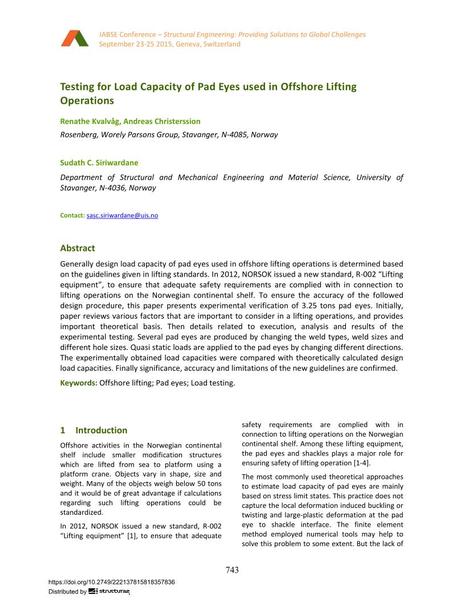Testing for Load Capacity of Pad Eyes used in Offshore Lifting Operations

|
|
|||||||||||
Bibliographic Details
| Author(s): |
Renathe Kvalvåg
(Rosenberg, Worely Parsons Group, Stavanger, N-4085, Norway)
Andreas Christerssion (Rosenberg, Worely Parsons Group, Stavanger, N-4085, Norway) Sudath C. Siriwardane (Department of Structural and Mechanical Engineering and Material Science, University of Stavanger, N-4036, Norway) |
||||
|---|---|---|---|---|---|
| Medium: | conference paper | ||||
| Language(s): | English | ||||
| Conference: | IABSE Conference: Structural Engineering: Providing Solutions to Global Challenges, Geneva, Switzerland, September 2015 | ||||
| Published in: | IABSE Conference Geneva 2015 | ||||
|
|||||
| Page(s): | 743-747 | ||||
| Total no. of pages: | 5 | ||||
| Year: | 2015 | ||||
| DOI: | 10.2749/222137815818357836 | ||||
| Abstract: |
Generally design load capacity of pad eyes used in offshore lifting operations is determined based on the guidelines given in lifting standards. In 2012, NORSOK issued a new standard, R-002 “Lifting equipment”, to ensure that adequate safety requirements are complied with in connection to lifting operations on the Norwegian continental shelf. To ensure the accuracy of the followed design procedure, this paper presents experimental verification of 3.25 tons pad eyes. Initially, paper reviews various factors that are important to consider in a lifting operations, and provides important theoretical basis. Then details related to execution, analysis and results of the experimental testing. Several pad eyes are produced by changing the weld types, weld sizes and different hole sizes. Quasi static loads are applied to the pad eyes by changing different directions. The experimentally obtained load capacities were compared with theoretically calculated design load capacities. Finally significance, accuracy and limitations of the new guidelines are confirmed. |
||||
| Keywords: |
load testing offshore lifting Pad eyes
|
||||
